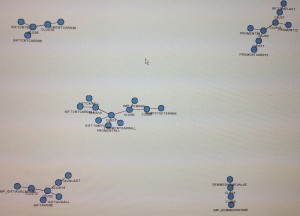SAS Enterprise Miner: The Best Case Scenario
I’m in North Carolina this week at a class for professors on Advanced Predictive Modeling using SAS Enterprise Miner. This is the sort of statement that causes The Spoiled One & Co. to make faces that look like this:
Despite my failure to impress fourteen-year-olds, I think the class has been well worth it.
I’m not naive, I realize that taking a class on a SAS product by a SAS instructor at the SAS facility represents the best case scenario. You know those IT people you always want to smack who say,
Well, I don’t know what’s wrong. It works on my computer.
Yeah, because your computer has maxed out RAM, the latest software and is in the same building as the server. Given that, if it doesn’t work on the the IT computer, you’re totally hosed.
So, if someone else has installed it for you, you have it running on a powerful computer with the latest version (7.1) and NOT the scaled down SAS On-Demand version and it doesn’t work, I would say Enterprise Miner is hopeless.
It’s not hopeless. It worked fine. All the problems I had were due to my own stupidity, like using a factor of .068 instead of 0.68 or forgetting to type SUM when writing a sum function and stuff like that.
On the other hand, those are the kind of problems that are quick and easy to find and fix.
There is a lot to like about SAS Enterprise Miner. Take this nifty little example from VARIABLE CLUSTERING
Think of it as a graph of a principal components analysis.
You can see which variables load together very easily. Imagine explaining this to a client over a rotated factor pattern.
The two best things about Enterprise Miner are diagrams like the one above and the enormous number of data mining procedures it offers.
The two worst things about Enterprise Miner are related to one of the best. Because it can do so much, learning it is quite complicated. I had thought I might use it in my class this fall but it is clearly going to be too much on top of what I have already planned. I am sticking with SAS Enterprise Guide. I am still toying with the idea of teaching a business school class in the spring using data mining, so if I do that Enterprise Miner is a possibility.
The worst thing about EM used to be the installation. You had to have 1,024 GB of RAM, sacrifice a flamingo and get your registry updated by seven of the twelve apostles before it would install. I just today met the first person who told me he had the damn thing installed – and he now works at SAS, which is probably why they hired him.
Amazingly, at least for the SAS On-Demand version, that seems to be a non-issue. I was in a hotel with a crummy wireless, using my old laptop that has 32-bit Windows 7 installed on bootcamp on a MacBook Pro. Enterprise Miner 7.1 started up and ran fine once I had the latest version of Java (and only one version of Java) installed. This incidentally isn’t the Java version they say is guaranteed to work, but it did.
Besides the complication of learning and installation, I think the other big drawback of EM if you are not at a university or college (for which it is free) is that it cost about a scadzillion dollars (that’s a zillion squared plus a bushel, 40 leagues and a peck, for you Europeans reading this).
The SAS On-Demand offerings are a good first step, but I think SAS is missing an opportunity to market to people and companies who don’t have more money than a Romney Super-PAC.
So that’s the good and the bad in a nutshell. The neutral is that more SAS programming was involved than I had expected. This did not bother me in the slightest but it might perturb you if you are used to SAS Enterprise Guide where you can go pretty much forever without programming (whether you should or not is a different issue).
The class was fun, so fun that I am now seriously wondering if I can clear my schedule enough to teach a class in the spring just so that I can inflict it on some unsuspecting graduate students. I think that might be fun, too.
.


Hi,
Can you please let me know the prerequisites for learning the Enterprise Miner 7.1
Good question. At a minimum, I would say a couple of years of statistics to understand what you are doing. You could get results but then understanding them is a different story. Some experience using SAS would certainly be helpful.